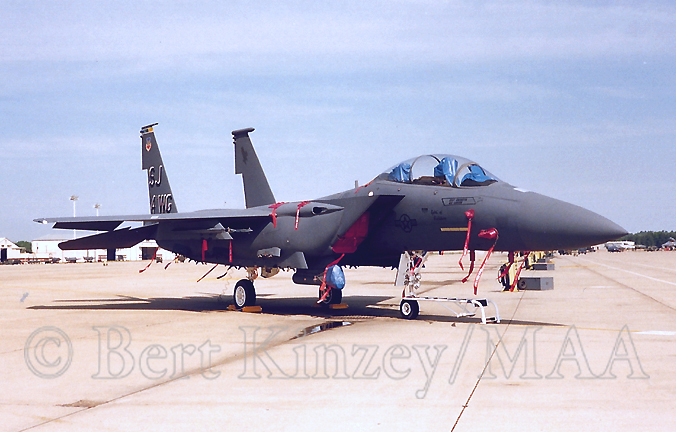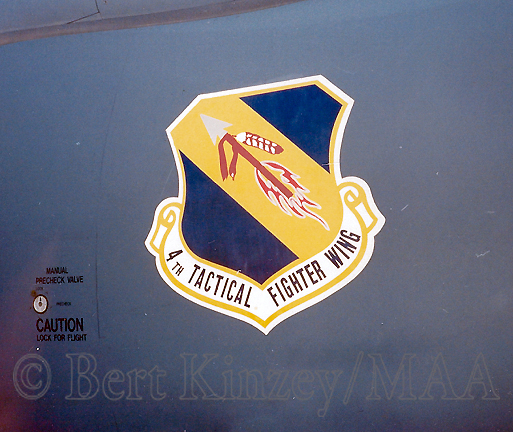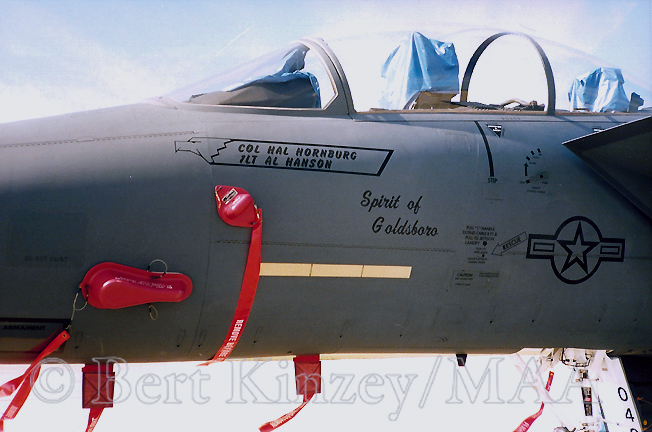F-15 Eagle Information File:
As the war in Vietnam came to a close, the U. S. Air Force realized that it needed a new fighter that would provide it with a clear edge over the fighters being flown by the Soviet Union and other potential enemies. North Vietnamese and Soviet pilots, flying MiG-17 Fresco and MiG-21 Fishbed fighters, had given American pilots all they could handle, and the Russians were known to be hard at work on new designs.
The Air Force conducted studies in 1964 and 1965 to determine the requirements for its new fighter. This resulted in a Request for Proposals (RFP) to the aircraft industry for a fighter dedicated to the air-superiority mission. It was to be the first fighter aircraft since the famous F-86 Sabre to be designed and optimized for this specific mission. All Air Force fighters since the Sabre had been either interceptors or fighter-bombers.
Eight companies initially submitted proposals, but after specifications were changed following the discovery of the existence of the MiG-25 Foxbat by U. S. intelligence, four revised proposals were submitted. On December 23, 1969, McDonnell Douglas was selected as the winner by the Air Force. Their design would become the F-15 Eagle.
The F-15 was a large fighter, being considerably bigger and heavier than the F-4 Phantom it was intended to replace. It had two engines, twin vertical tails, and a fixed wing. Its Pratt & Whitney F100-PW-100 engines were so powerful that they produced more thrust than the weight of the aircraft, giving it a better than 1 to 1 thrust-to-weight ratio. The Air Force publicized that the Eagle would be able to accelerate while climbing straight up. Soon after production began, an F-15A, named the “Streak Eagle” set several time-to-climb records to publically demonstrate this amazing capability.
Lessons learned early in Vietnam illustrated that even in the age of guided missiles, fighters still needed an internal gun system, so a 20-mm M61 Vulcan cannon was inside the right wing root. Infrared AIM-9 Sidewinder and radar-guided AIM-7 Sparrow air-to-air missiles also armed the new air superiority fighter. A look-down, shoot-down radar made it possible for the F-15 pilot to find and attack targets below him. This was a considerable improvement over previous radars that had difficulty finding targets below the attacking aircraft due to ground clutter picked up by the radar.
Production began with two different versions, the single-seat F-15A and the two-seat TF-15A, but the latter was soon changed to F-15B. This change in designation reflected the fact that the two-seater was not simply a trainer, but that it had all of the combat capabilities of the single-seat F-15A. In early 1976, these two versions began replacing F-4 Phantoms in several of the Air Force’s fighter wings, but improvements were already planned for the new fighter. The F-15C and F-15D versions replaced the F-15A and F-15B on the production lines only two years later in 1978.
The two new versions could carry more internal fuel, could be fitted with external conformal fuel tanks, and had improvements to the radar, computer, and fire control systems. To handle the heavier weight on the ground, the landing gear was strengthened. The powerplants were upgraded to the Pratt & Whitney F100-PW-220.
The Multistage Improvement Program (MSIP) began in February 1983, and over several years it added the ability to carry the AIM-120 AMRAAM air-to-air missile. MSIP also upgraded the radar, computer, and avionics system. The electronic warfare gear was also enhanced.
In response to the Air Force competition for a dual-role fighter in 1982, McDonnell Douglas modified a two-seat F-15B to what would become the F-15E Strike Eagle configuration. Using a Hughes APG-70 radar and additional weapon stations on the conformal fuel tanks, the large airframe of the Eagle proved that it was very capable of carrying and delivering the latest in air-to-ground weapons while still retaining the excellent air-to-air capability of the earlier Eagle variants. The F-15E was chosen as the Air Force’s new dual-role fighter in 1984. Deliveries began in April 1988 to the 405th Tactical Training Wing at Luke AFB, Arizona. The 4th Tactical Fighter Wing at Seymour Johnson AFB, North Carolina, became the first combat wing to receive the Strike Eagle, and before all three of its squadrons had transitioned to the F-15E, it took the Strike Eagle to war for the first time in Operation Desert Storm in 1991. In the years that followed, the F-15E replaced the F-4 Phantom and F-111 Aardvark as the primary fighter-bomber in the Air Force inventory.
Equipped with Low-Altitude Navigation and Targeting Infrared for Night (LANTIRN) pods, the Strike Eagle can navigate, find its targets, and attack them in all weather conditions both day and night. The navigation pod, carried under the right engine inlet, houses a terrain-following radar that allows the pilot to fly nap-of-the-earth mission profiles at very low altitude to avoid enemy radar detection. It has a hands-off feature, flying the aircraft itself through the autopilot without the pilot needing to touch the controls. The targeting pod has a laser designator and a tracking system to provide targeting information to both laser and GPS guided munitions. Alternatively, Sniper or LITENING targeting pods can also be carried under the left inlet.
A modified version of the F-15E, known as the F-15K is operational with the South Korean Air Force. A similar version, designated the F-15SG, has entered service with the Royal Singapore Air Force.
Through more than thirty-five years of service, constant upgrades have kept the F-15 on the front lines in the air forces of the United States, Israel, Japan, Saudi Arabia, Korea, and Singapore. It has served in Desert Storm, Operation Iraqi Freedom, and in a number of actions by the Israelis. In combat, F-15s have shot down more than 100 enemy aircraft without any losses due to enemy aircraft. During Operation Desert Storm, USAF F-15s shot down thirty-four Iraqi aircraft of various types ranging from fighters to helicopters. In one case, an F-15E Strike Eagle dropped a laser-guided bomb on and airborne Iraqi helicopter, blowing it out of the air.
As F-15Cs and F-15Ds replaced the earlier F-15A and F-15B in active Air Force squadrons, the older versions were assigned to Air National Guard fighter interceptor squadrons (FIS) in several states. These remained in service until 2009. While F-22 Raptors have replaced some of the F-15Cs, the Air Force plans to keep a considerable number of F-15Cs in service for at least another decade. F-15E Strike Eagles will continue to serve as a primary air-to-ground weapon system for at least that long as well.
F-15A Characteristics (USAF Standard Aircraft Characteristics, January 1976)
| Span: | 42.81 feet |
| Length: | 63.75 feet |
| Height: | 18:45 feet |
| Wing Area | 608 square feet |
| Powerplant | 2 Pratt & Whitney F100-PW-100 |
| Thrust (Maximum) | 23,840 pounds in afterburner (each engine) |
| Thrust (Sustained) | 12,410 pounds (each engine) |
| Fuel Capacity | 3,514 gallons (maximum internal and external combined) |
| Armament | 1 X 20mm M61 cannon with 938 rounds, 4 X AIM-9, 4 X AIM-7 * |
| Empty Weight | 25,870 pounds |
| Combat Weight | 37,589 pounds |
| Take-off Weight | 44,497 pounds |
| Rate of Climb | 67,250 feet-per-minute, clean, maximum power |
| 18,680 feet-per-minute, sea level, take-off weight, intermediate power | |
| Maximum Ceiling | 63,050 feet, combat weight, maximum power |
| Combat Ceiling | 49,830 feet, take-off weight, intermediate power |
| Maximum Speed | 1,434 knots, 45,000 feet, maximum power |
| Combat Speed | 893 knots, 10,000 feet, maximum power |
| Combat Radius | 242 nautical miles, air superiority mission |
| 638 nautical miles, counter air mission | |
| 372 nautical miles, air intercept mission | |
| Ferry Range | 2,362 nautical miles |
* Although the F-15A was certified to carry various air-to-ground weapons, this was not done operationally.
F-15C Characteristics (USAF Standard Aircraft Characteristics, February 1992)
(Data is for F-15C Without Conformal Fuel Tanks)
| Span: | 42.81 feet |
| Length: | 63.75 feet |
| Height: | 18:58 feet |
| Wing Area | 608 square feet |
| Powerplant | 2 Pratt & Whitney F100-PW-220 |
| Thrust (Maximum) | 23,450 pounds in afterburner (each engine) |
| Thrust (Sustained) | 12,420 pounds (each engine) |
| Fuel Capacity | 3,900 gallons |
| Armament | 1 X 20mm M61 cannon with 940 rounds carried internally plus air-to-air missiles and air-to-ground weapons of all USAF types * |
| Empty Weight | 28,476 pounds |
| Combat Weight | 45,713 pounds |
| Take-off Weight | 68,000 pounds |
| Rate of Climb | 67,050 feet-per-minute, clean, maximum power |
| 15,250 feet-per-minute, sea level, take-off weight, intermediate power | |
| Maximum Ceiling | 58,870 feet, clean, maximum power |
| Combat Ceiling | 46,750 feet, take-off weight, intermediate power |
| Maximum Speed | 1,340 knots at 45,000 feet |
| Combat Speed | 857 knots, air superiority mission |
| Combat Radius |
235 nautical miles, air superiority mission
|
|
551 nautical miles, counter air mission
|
|
|
470 nautical miles, air intercept mission
|
|
| Ferry Range |
1,933 nautical miles with external tanks retained
|
* Although the F-15C was certified to carry various air-to-ground weapons, this was not done operationally.
F-15E Characteristics (Official USAF Characteristics)
| Span: |
42.81 feet
|
| Length: |
63.75 feet
|
| Height: |
18:58 feet
|
| Wing Area |
608 square feet
|
| Powerplant |
2 Pratt & Whitney F100-PW-220 or F100-PW-229
|
| Thrust (Maximum) |
29,000 pounds in afterburner (each engine)
|
| Fuel Capacity |
5,570 gallons
(internal fuel, 3 external tanks, and 2 conformal tanks) |
| Armament |
1 X 20mm M61 cannon with 500 rounds carried internally plus
air-to-air missiles and air-to-ground weapons of all USAF types |
| Weight |
37,500 pounds
|
| Maximum Ceiling |
60,000 feet
|
| Maximum Speed |
1,875 miles-per-hour
|
| Ferry Range |
2,400 miles
|
F-15E Strike Eagle, 4th Wing:
Immediately after Desert Storm
In 1991, Operation Desert Storm provided the first combat test for the U. S. Air Force’s new F-15E Strike Eagle. Operating out of Al Kharj Air Base, Saudi Arabia, and flying with the 4th Tactical Fighter Wing, then the only operational wing in the Air Force equipped with the F-15E, the Strike Eagle proved its worth by hunting and destroying Scud missiles, command and control links, armor and other vehicles, airfields, and Iraqi convoys. The 4th TFW (redesignated the 4th Wing immediately after the war) flew approximately 2,200 missions while maintaining a 95.9 percent mission-capable rate. This was eight percent higher than in peacetime. During Operation Desert Storm, the 4th Tactical Fighter Wing lost two F-15Es in combat.
The forty-eight F-15Es that took part in Operation Desert Storm were equally divided into two squadrons. These were the 335th and 336th Tactical Fighter Squadrons. The 4th TFW’s third squadron had not completed transitioning to the F-15E at the time the war began, so they did not deploy with the other two squadrons.
Shortly after their return from Desert Storm, Bert Kinzey traveled to the 4th Wing’s home at Seymour Johnson AFB, North Carolina, to photograph the aircraft, some of which were still wearing their mission markings from the war. This photo set provides a look at some of the aircraft that were on the ramp that day only a few weeks after they had participated in combat.
The photograph included with this introduction shows an F-15E Strike Eagle of the 4th TFW about to depart for a mission during Operation Desert Storm. In addition to Sidewinder air-to-air missiles, it carries a load of Mk 20 Rockeye cluster bombs. (Bennett via Davenport)



































